Geodynamic ‘Hotspots’ in a Periglacial Landscape: Natural Hazards and Impacts on Productive Activities in Chilean Fjordlands, Northern Patagonia
Abstract
1. Introduction
2. Study Area
Climatic Conditions
3. Methodology
Land/Water Use and Impacts on Geohazards
4. Results
4.1. Landslide Hazards
4.2. Flood and Tsunami Hazards
4.3. Geohazard ‘Hotspots’ and Their Impacts
4.4. Land and Sea Use in the Comau Fjord
5. Impact of Tsunami and Landslide Hazards
6. Conclusions
Author Contributions
Funding
Data Availability Statement
Acknowledgments
Conflicts of Interest
References
- Goudie, A.S. (Ed.) Arid and Semi-Arid Geomorphology; Cambridge University Press: New Yok, NY, USA, 2013; ISBN 9780511794261. [Google Scholar]
- Neumann, B.; Vafeidis, A.T.; Zimmermann, J.; Nicholls, R.J. Future Coastal Population Growth and Exposure to Sea-Level Rise and Coastal Flooding—A Global Assessment. PLoS ONE 2015, 10, e0131375. [Google Scholar] [CrossRef] [PubMed]
- Sarmiento, J.P.; Hoberman, G.; Ilvecha, M.; Asgary, A.; Majano, A.M.; Poggione, S.; Duran, L.R. Private sector and disaster risk reduction: The cases of Bogotá, Miami, Kingston, San José, Santiago and Vancouver. Int. J. Disaster Risk Reduct. 2015, 14, 225–237. [Google Scholar] [CrossRef]
- Calil, J.; Reguero, B.G.; Zamora, A.R.; Losada, I.J.; Méndez, F.J. Comparative Coastal Risk Index (CCRI): A multidisciplinary risk index for Latin America and the Caribbean. PLoS ONE 2017, 12, e0187011. [Google Scholar] [CrossRef] [PubMed]
- Cardona, O. Environmental Management and Disaster Prevention: Two Related Topics—A Holistic Risk Assessment and Management Approach. Nat. Disaster Manag. 1999, 4, 151–153. [Google Scholar]
- Castro, C.P.; Ibarra, I.; Lukas, M.; Sarmiento, J.P. Disaster risk construction in the progressive consolidation of informal settlements: Iquique and Puerto Montt (Chile) case studied. Int. J. Disaster Risks Reduct. 2015, 13, 109–127. [Google Scholar] [CrossRef]
- Wisner, B.; Blaikie, P.M.; Blaikie, P.; Cannon, T.; Davis, I. At Risk, Natural Hazards People’s Vulnerability and Disaster; Routledge: London, UK, 2004. [Google Scholar]
- Alcamo, J.; Flörke, M.; Märker, M. Future long-term changes in global water resources driven by socio-economic and climatic changes. Hydrol. Sci. J. 2007, 52, 247–275. [Google Scholar] [CrossRef]
- Barton, J.R.; Irrarázabal, F. Adaptación al cambio climático y gestión de riesgos naturales: Buscando síntesis en la planificación urbana. Rev. Geogr. Norte Gd. 2016, 63, 87–110. [Google Scholar] [CrossRef]
- Bouwer, L.M. Have disaster losses increased due to anthropogenic climate change? Bull. Amer. Meteor. Soc. 2011, 92, 39–46. [Google Scholar] [CrossRef]
- Lei, Y. A preliminary discussion on the opportunities and challenges of linking climatic changes adaptation with risk reduction. Nat. Hazards 2014, 71, 1587–1597. [Google Scholar] [CrossRef]
- Märker, M.; Angeli, L.; Bottai, L.; Costantini, R.; Ferrari, L.; Innocenti, L.; Siciliano, G. Assessment of land degradation susceptibility by scenario analysis. A case study in Southern Tuscany, Italy. Geomorphology 2008, 3, 120–129. [Google Scholar] [CrossRef]
- Altieri, M.A.; Rojas, A. Ecological Impacts of Chile’s Neoliberal Policies, with Special Emphasis on Agroecosystems. Environ. Dev. Sustain. 1999, 1, 55–72. [Google Scholar] [CrossRef]
- Barton, J.R.; Fløysand, A. The political ecology of Chilean salmon aquaculture, 1982–2010: A trajectory from economic development to global sustainability. Glob. Environ. Chang. 2010, 20, 739–752. [Google Scholar] [CrossRef]
- Barton, J.R.; Román, A. Sustainable development? Salmon aquaculture and late modernity in the archipelago of Chiloé, Chile. Islan Stud. J. 2016, 11, 651–672. [Google Scholar] [CrossRef]
- Bustos, B. Brote del virus ISA: Crisis ambiental y capacidad de la institucionalidad ambiental para manejar el conflicto. Rev. EURE 2012, 38, 21–245. [Google Scholar] [CrossRef]
- Iizuka, M.; Kats, J. Globalisation, sustainability and the role of institutions: The case of the chilean salmon industry. Tijdschr. Econ. Soc. Geogr. 2015, 106, 140–153. [Google Scholar] [CrossRef]
- Wilcox, B.P.; Sorice, M.G.; Young, M.H. Dryland ecohydrology in the anthropocene: Taking stock of human–ecological interactions. Geogr. Compass 2011, 5, 112–127. [Google Scholar] [CrossRef]
- Beniston, M.; Stoffel, M.; Hill, M. Assessing Climate Impacts on the Quantity and Quality of Water (ACQWA); The EU/FP7 ACQWA Project Science and Policy Brief. A Large Integrating Project under EU R&D Framework Programme 7 (FP7); Université de Genéve: Geneva, Switzerland, 2013. [Google Scholar]
- Ilustre Municipalidad de Chaitén. Plan de Desarrollo Comunal de Chaitén, 2016–2019; Ilustre Municipalidad de Chaitén: Santiago, Chile, 2016. [Google Scholar]
- Ilustre Municipalidad de Hualaihué. Plan de Desarrollo Comunal de Hualaihué 2014–2017; Ilustre Municipalidad de Hualaihué: Santiago, Chile, 2014. [Google Scholar]
- Hervé, F.; Fuentes, F.; Calderón, M.; Fanning, M.; Quezada, P.; Pankhurst, R.; Rapela, C. Ultramafic rocks in the North Patagonian Andes: Is their emplacement associated with the Neogene tectonics of the Liquiñe-Ofqui Fault Zone. Andean Geol. 2017, 44, 1–16. [Google Scholar] [CrossRef]
- Vargas, G.; Rebolledo, S.; Sepúlveda, S.A.; Lahsen, A.; Thiele, R.; Townley, B.; Lara, M. Submarine earthquake rupture, active faulting and volcanism along the major Liquiñe-Ofqui Fault Zone and implications for seismic hazard assessment in the Patagonian Andes. Andean Geol. 2013, 40, 141–171. [Google Scholar] [CrossRef]
- Sarricolea, P.; Herrera-Ossandón, M.; Meseguer-Ruiz, Ó. Climatic regionalisation of continental Chile. J. Maps 2017, 13, 66–73. [Google Scholar] [CrossRef]
- Diaz, C. Análisis de Variaciones Areales de los Glaciares Ubicados en las Cuencas de Vodudahüe y Cahuelmó Durante el Período 1985–2017; Universidad de Chile: Santiago, Chile, 2018. [Google Scholar]
- Levi, B.; Aguilar, A.; Fuenzalida, R. Reconocimiento Geológico en las Provincias de Llanquihue y Chiloé; Instituto de Investigaciones Geológicas: Santiago, Chile, 1996. [Google Scholar]
- Sernageomin. Mapa Geológico de Chile: Versión Digital. Servicio Nacional de Geología y Minería, Carta Geológica de Chile, escala 1:1,000,000. Serie Geología Básica. 2003. Available online: https://www.sernageomin.cl/geologia/ (accessed on 10 October 2022).
- Sernageomin-BRGM. Carta Metalogénica X Región sur. Servicio Nacional de Geología y Minería–Bureau de Recherches Géologiques et Minières. Informe Registrado IR-95-05, 4Tomos. 2005. Available online: https://www.sernageomin.cl/geologia (accessed on 10 February 2022).
- Molina, C. Análisis de Susceptibilidad de Remociones en Masa en las Costas del Fiordo Comau, X Región, Chile; Universidad de Chile, Facultad de Ciencias Físicas y Matemáticas: Santiago, Chile, 2017. [Google Scholar]
- Soto, M.V.; Sarricolea, P.; Sepúlveda, S.A.; Cabello, M.; Ibarra, I.; Maerker, M. Geohazards in the North Patagonian Fjordland, Comau, Chile. In Sea Level Rise and Coastal Infrastructure; InTech, Open Science: London, UK, 2018; pp. 99–118. [Google Scholar] [CrossRef]
- Hungr, O.; Leroueil, S.; Picarelli, L. The Varnes classification of landslide types, an update. Landslides 2014, 11, 167–194. [Google Scholar] [CrossRef]
- Náquira, V. Susceptibilidad Remociones en Masa en las Costas de Fiordos Cercanos a Hornopirén; Universidad de Chile: Santiago, Chile, 2009. [Google Scholar]
- Sepúlveda, S.A.; Serey, A. Tsunamigenic, earthquake-triggered rock slope failures during the April 21, Aisén earthquake, southern Chile (45.5° S). Andean Geol. 2009, 36, 131–136. [Google Scholar] [CrossRef]
- Sepúlveda, S.A.; Serey, A.; Lara, M.; Pavez, A.; Rebolledo, S. Landslides induced by the April 2007 Aysén Fjord earthquake, Chilean Patagonia. Landslides 2010, 7, 483–492. [Google Scholar] [CrossRef]
- Van-Western, C.J. Use of Weights of Evidence Modelling for Landslide Susceptibility Mapping Lecture Notes; International Institute for Geoinformation Science and Earth Observation (ITC): Enschede, The Netherlands, 2003; pp. 1–21. [Google Scholar]
- Zevenbergen, L.W.; Thorne, C.R. Quantitative analysis of land surface topography. Earth Surf. Process. Landf. 1987, 12, 47–56. [Google Scholar] [CrossRef]
- Dahal, R.K.; Hasegawa, S.; Nonomura, A.; Yamanaka, M.; Masuda, T.; Nishino, K. GIS-based weights-of-evidence modelling of rainfall-induced landslides in small catchments for landslide susceptibility mapping. Environ. Geol. 2008, 54, 311–324. [Google Scholar] [CrossRef]
- Oppikofer, T.; Jaboyedoff, M.; Blikra, L.; Derron, M.H.; Metzger, R. Characterization and monitoring of the Åknes rockslide using terrestrial laser scanning. Nat. Hazards Earth Syst. Sci. 2009, 9, 1003–1019. [Google Scholar] [CrossRef]
- Bachofer, F.; Quénéhervé, G.; Hochschild, V.; Märker, M. Multisensoral Topsoil Mapping in the Semiarid Lake Manyara Region. Northern Tanzania. Remote Sens. 2015, 7, 9563–9586. [Google Scholar] [CrossRef]
- Scopesi, C.; Maerker, M.; Bachofer, F.; Rellini, I.; Firpo, M. Assessment of flash floods in a small Mediterranean catchment using terrain analysis and remotely sensed data: A case study in the Torrente Teiro, Liguria, Italy. Z. Geomorphol. 2017, 61, 137–163. [Google Scholar] [CrossRef]
- Servicio Hidrológico y Oceanográfico de la Armada, Puerto Aysén-Puerto Chacabuco. Carta de Inundación por Tsunami Generado por Remociones en Masa. 2007. Available online: http://www.shoa.cl/servicios/citsu/pdf/citsu_aysen_low.pdf (accessed on 10 February 2022).
- Naranjo, J.A.; Arenas, M.; Clavero, J.; Muñoz, O. Mass movement-indiced tsunamis: Main effects during the Pataonian fjorland seismic crisis Aisén (45°25′ S), Chile. Andean Geol. 2009, 36, 137–145. [Google Scholar] [CrossRef]
- Petley, D. Landslide hazards. In Geomorphological Hazards and Disaster Prevention; Alcántara-Ayala, I., Goudie, A.S., Eds.; Cambridge University Press: Cambridge, UK, 2010; pp. 63–74. [Google Scholar]
- Hearn, G.J.; Griffiths, J.S. Landslide Hazard Mapping and Risk Assessment. In Land Surface Evaluation for Engineering Practice. Geological Society; Griffiths, J.S., Ed.; Engineering Group Special Publication: London, UK, 2001; Volume 18, pp. 43–52. [Google Scholar]
- Aubrecht, C.; Fuchs, S.; Neuhold, C. Spatio-temporal aspects and dimensions in integrated disaster risk management. Nat. Hazards 2013, 68, 1205–1216. [Google Scholar] [CrossRef]
- Reyes, O.; Méndez, C.; San Román, M.; Francois, J.P. Earthquakes and coastal archaeology: Assessing shoreline shifts on the southernmost Pacific coast (Chonos Archipelago 43°50′–46°50′ S, Chile, South America). Quat. Int. 2018, 463, 161–175. [Google Scholar] [CrossRef]
- Lange, D.; Cembrano, J.; Rietbrock, A.; Haberland, C.; Dahm, T.; Bataille, K. First seismic record for intra-arc strike-slip tectonics along the Liquiñe-Ofqui fault zone at the obliquely convergent plate margin of the southern Andes. Tectonophysics 2008, 455, 14–24. [Google Scholar] [CrossRef]
- Villalobos, A.; Easton, G.; Maksymowicz, A.; Ruiz, S.; Lastras, G.; De Pascale, G.P.; Agurto-Detzel, H. Active Faulting, Submarine Surface Rupture, and Seismic Migration Along the Liquiñe-Ofqui Fault System, Patagonian Andes. J. Geophys. Res. Solid Earth 2020, 125, e2020JB019946. [Google Scholar] [CrossRef]
- Blikra, L.H.; Longva, O.; Braathen, A.; Anda, E.; Dehls, J.F.; Stalsberg, K. Rock slope failures in Norwegian fjord areas: Examples, spatial distribution and temporal pattern. In Landslides from Massive Rock Slope Failure; Springer: Dordrecht, The Netherlands, 2006; Volume 49, pp. 475–496. [Google Scholar] [CrossRef]
- González, N. Análisis y Caracterización Temporo-Espacial de la Morfología Fan-Delta en la Localidad de Huinay, Fiordo Comau, Región de los Lagos; Universidad de Chile: Santiago, Chile, 2016. [Google Scholar]
- Fløysand, A.; Barton, J.R.; Román, A. La doble jerarquía del desarrollo económico y gobierno local en Chile: El caso de la salmonicultura y los municipios chilotes. Revista EURE 2010, 36, 123–148. [Google Scholar] [CrossRef]
- French-Davis, R. Reformas económicas en Chile (1973–2017). Neoliberalismo, crecimiento con equidad, inclusión. Taurus 2018, 598. [Google Scholar]
- Arratia, P. Análisis de la Vulnerabilidad y el Riesgo de las Actividades Económicas: Pesca, Acuicultura y Turismo, Frente a las Amenazas de Origen Natural en el Fiordo Comau, Región de los Lagos; Universidad de Chile: Santiago, Chile, 2017; Available online: https://repositorio.uchile.cl/handle/2250/144236 (accessed on 15 June 2017).
- Wang, Y.; Sakate, K.; Cienfuegos, R.; Quiroz, M.; Navarrete, P. Far-field tsunami data assimilation for the 2015 Illapel earthquake. Geophys. J. Int. 2019, 219, 514–521. [Google Scholar] [CrossRef]
- Wang, Y.; Tsushima, H.; Sakate, K.; Navarrete, P. Review on Recent Progress in Near-Field Tsunami Forecasting Using Offshore Tsunami Measurements: Source Inversion and Data Assimilation. Pure Appl. Geophys. 2021, 178, 5109–5128. [Google Scholar] [CrossRef]
- Nogueira, F.R.; Oliveira, V.E.; Canil, K. Regional public policy for risk management: The implementation process in the greater ABC region, São Paulo city metropolitan region. Ambiente Soc. 2014, 17, 177–194. [Google Scholar] [CrossRef]
- World Bank. Informe Sobre el Desarrollo Mundial—Riesgo y Oportunidad: La Administración del Riesgo Como Instrumento de Desarrollo—Panorama General: Risk and Opportunity—Managing Risk for Development; World Bank: Washington, DC, USA, 2013. [Google Scholar]
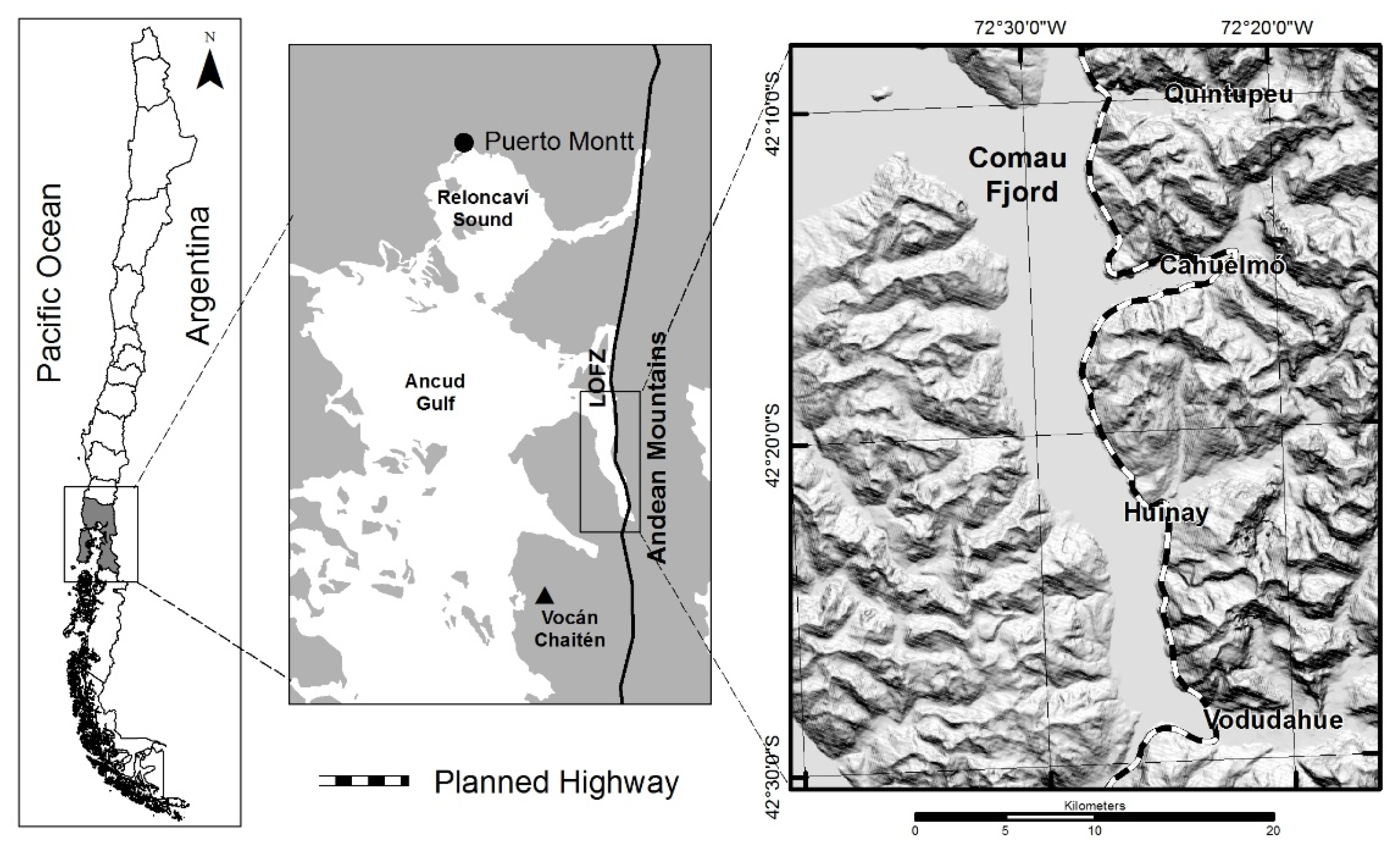
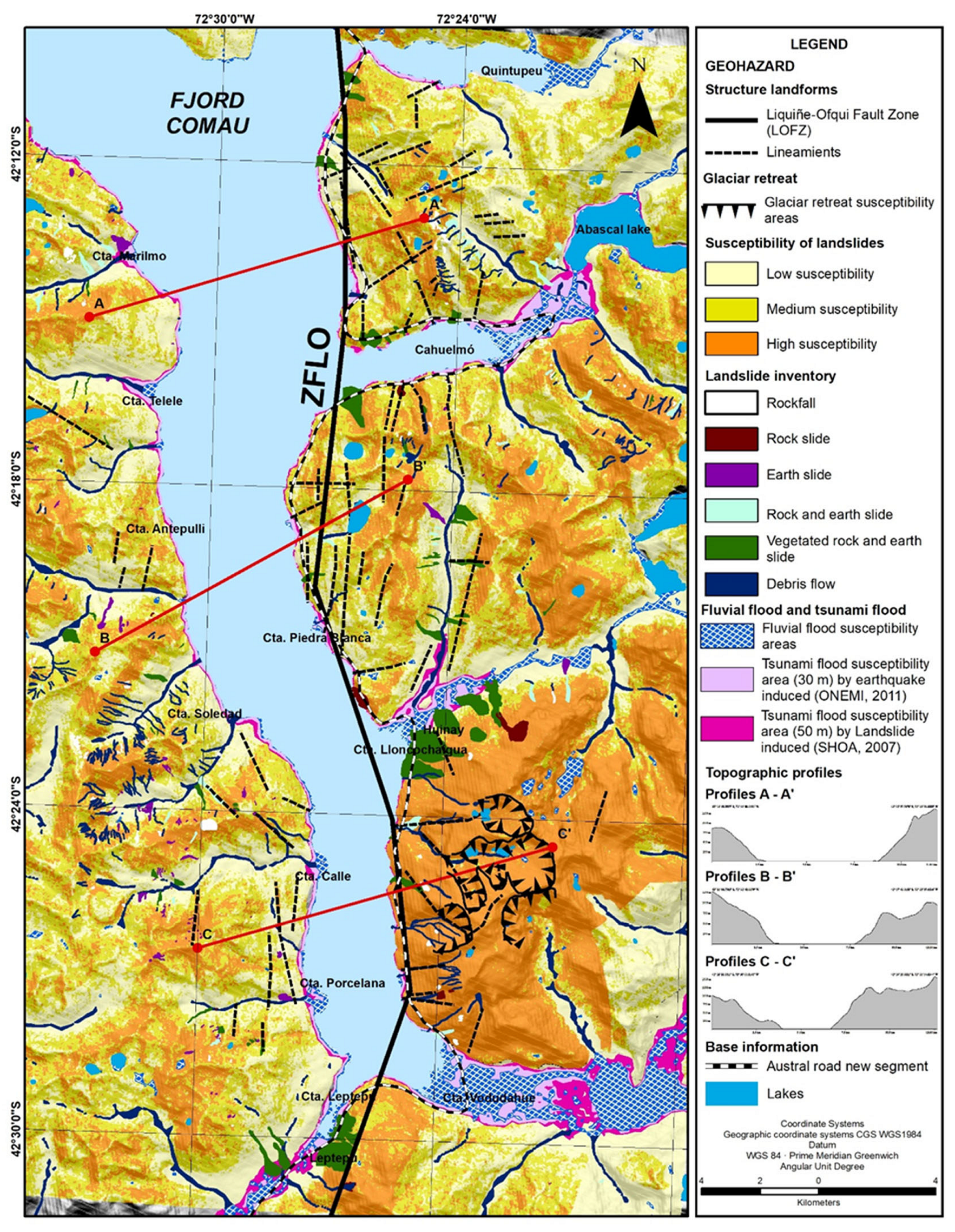
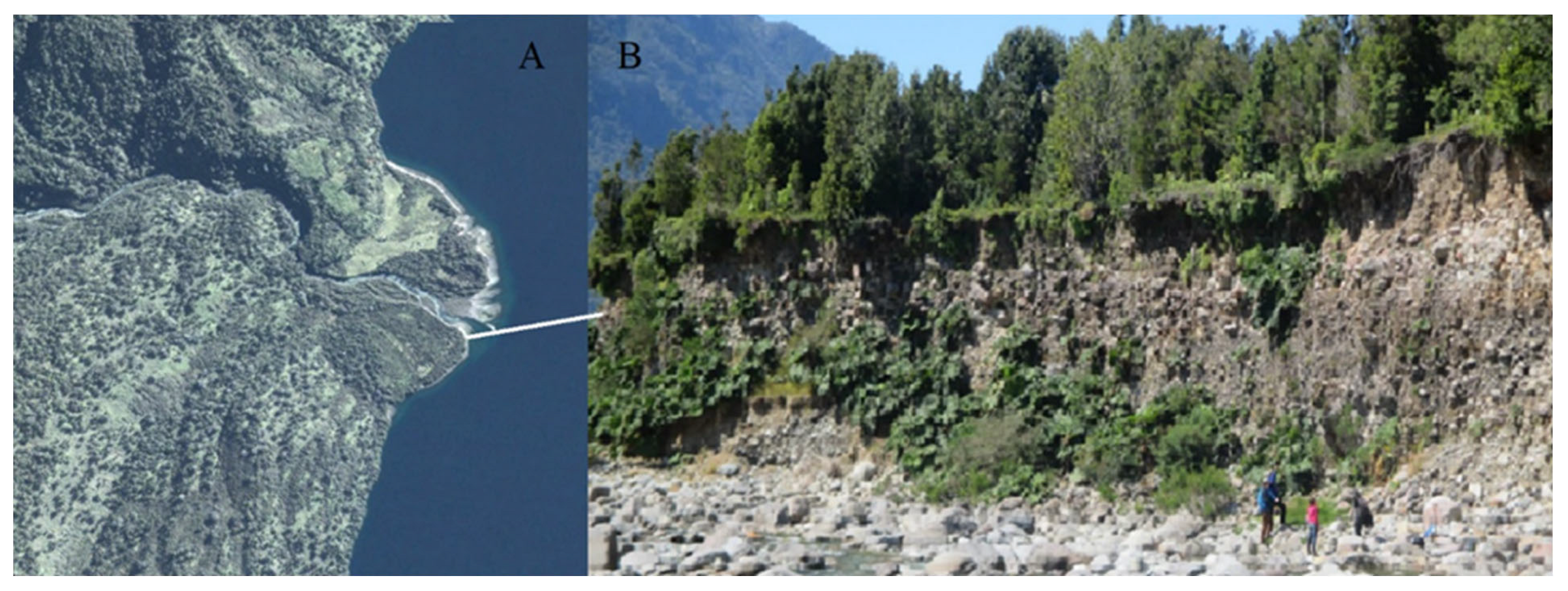

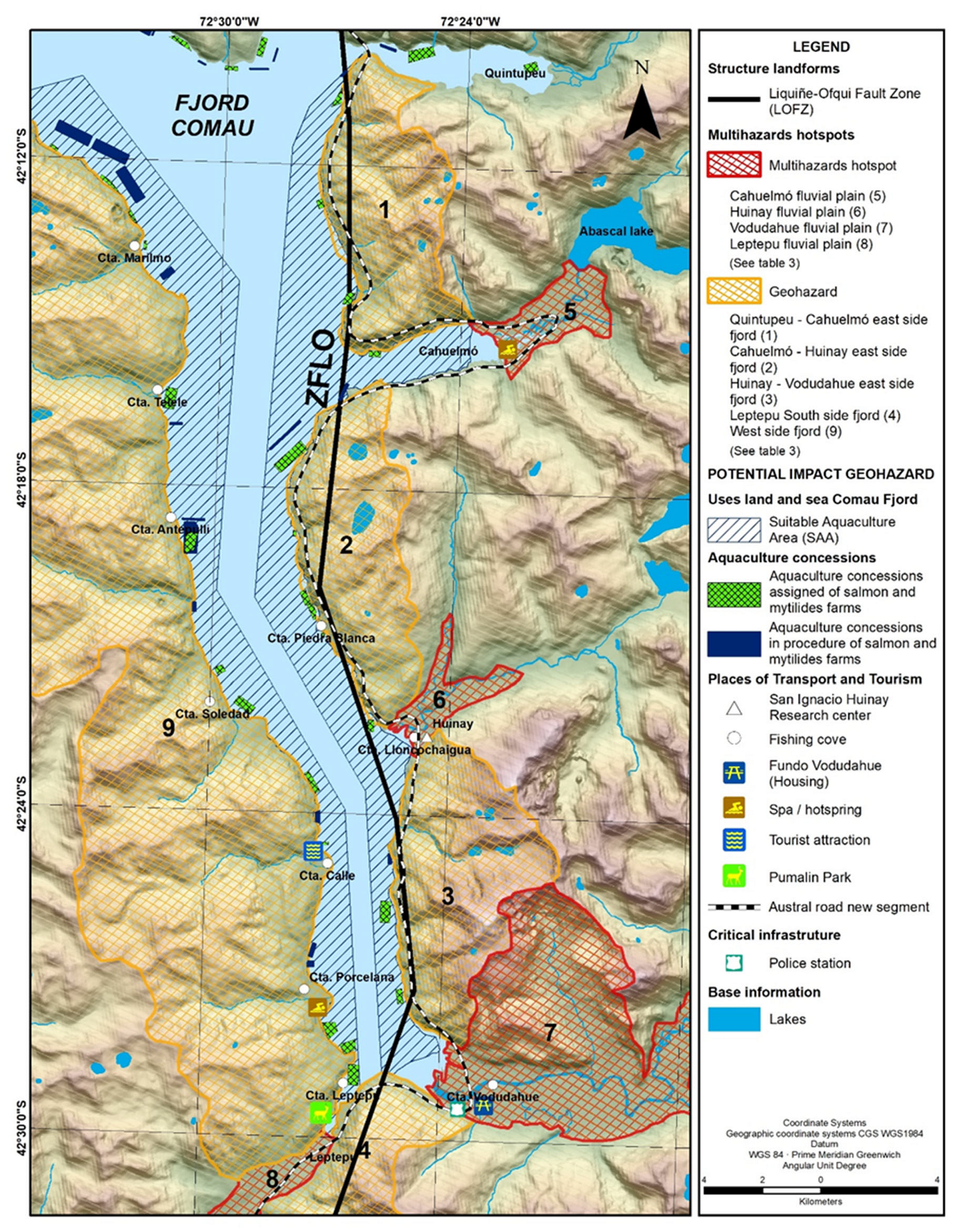
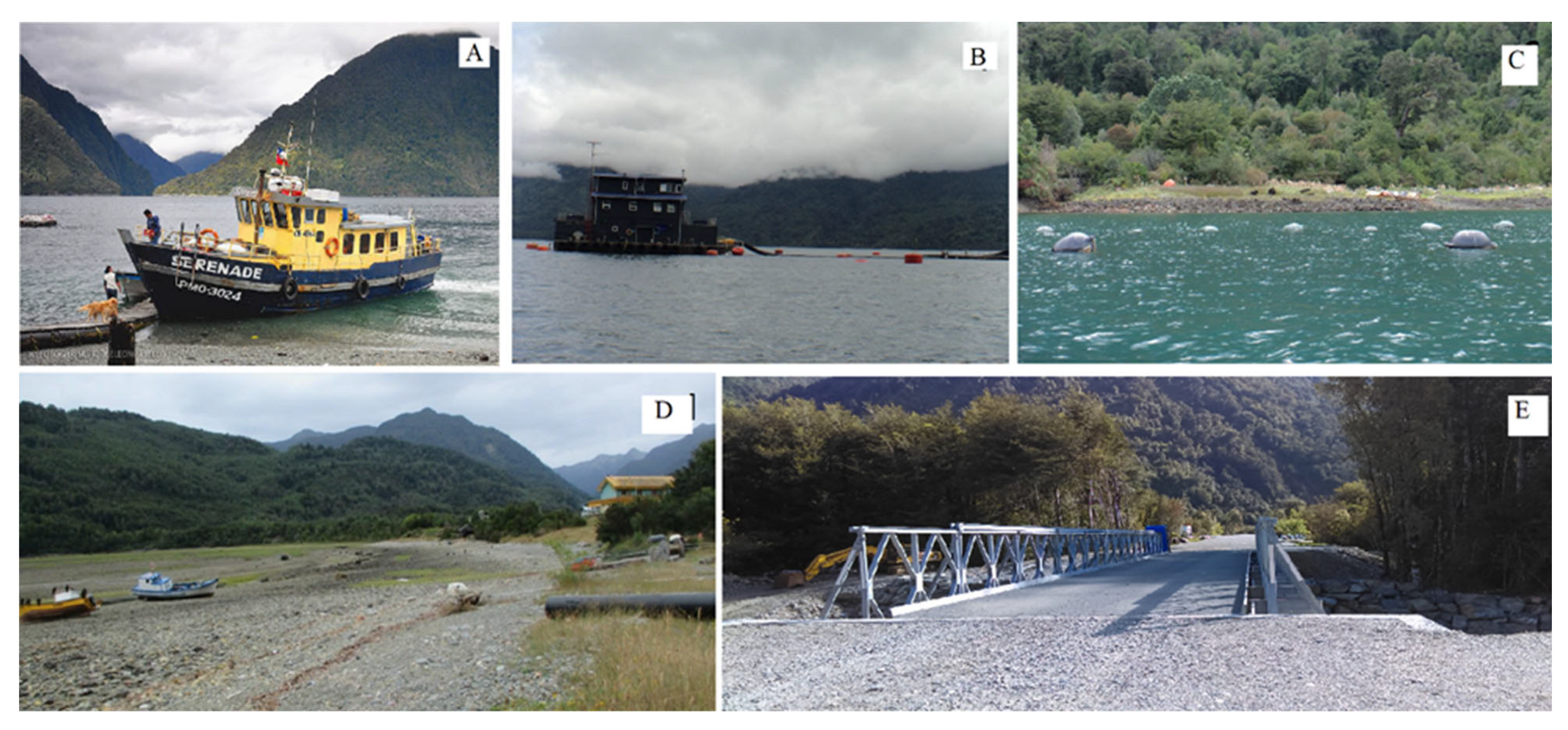
| Conditioning Factors | Description | Weight | Rank | Percentage (Weight) |
|---|---|---|---|---|
| Slope | 0–15° | 1 | low | 35% (0.35) |
| 15–35° | 2 | medium | ||
| 35–>55° | 3 | high | ||
| Parent material (rock resistance) | 1–25 MPa (soft rocks) | 1 | low | 20% (0.2) |
| 25–100 MPa (hard rocks) | 2 | medium | ||
| 100–>250 MPa (very hard rocks) | 3 | high | ||
| Distance to faults and lineamets | >600 m | 1 | low | 15% (0.15) |
| >200 y < 600 m | 2 | medium | ||
| <200 m | 3 | high | ||
| Lineament density | 0–0.5 (m/km2) | 1 | low | 15% (0.15) |
| 0.5–1.5 (m/km2) | 2 | medium | ||
| 1.5–3 (m/km2) | 3 | high | ||
| Landslide inventory | Absence | 1 | low | 15% (0.15) |
| Presence | 3 | high | ||
| Source: Proyecto FONDECYT N° 1151087. | ||||
| GEOHAZARDS/‘HOTSPOT’S | |||||||
|---|---|---|---|---|---|---|---|
| LANDFORMS ZONE (See Figure 5) | SUSCEPTIBILITY TO LANDSLIDES | RIVER FLOOD SUSCEPTBILITY AREAS | OCEANIC TSUNAMI FLOOD SUSCEPTBILITY AREAS | LANDSLIDE TSUNAMI FLOOD SUSCEPTBILITY AREAS | GLACIAL RETREAT | TOTAL GEOHAZARDS | MULTIHAZARDS OVERLAP ‘HOTSPOT’ |
| (1) Quintupeu—Cahuelmó east side of fjord | X | - | - | X | - | 2 | - |
| (2) Cahuelmó—Huinay east side of fjord | X | - | - | X | - | 2 | - |
| (3) Huinay—Vodudahue east side fjord | X | - | - | X | - | 2 | - |
| (4) Leptepu—south side of fjord | X | - | - | X | - | 2 | - |
| (5) Cahuelmó fluvial plain | X | X | X | X | - | 4 | X |
| (6) Huinay fluvial plain | X | X | X | X | - | 4 | X |
| (7) Vodudahue fluvial plain | X | X | X | X | X | 5 | X |
| (8) Leptepu fluvial plain | X | X | X | X | - | 4 | X |
| (9) West side of fjord | X | - | - | X | - | 2 | - |
| Activity/Land Use | Area Potentially Affected by Floods Due to Oceanic Tsunamis Hazard at 30 m.a.s.l. (%) | Area Potentially Affected by Floods Due to Oceanic Tsunami Hazard at 50 m.a.s.l. (%) |
|---|---|---|
| Existing Use | ||
| Tourism | 88% | 88% |
| Transport | 100% | 100% |
| Fishing | 100% | 100% |
| Maritime occupation | 100% | 100% |
| Police Station | 100% | 100% |
| Projected Use | ||
| Transport | 19% | 27% |
| Maritime occupation | 100% | 100% |
| Activity/Land Use | Direct | Indirect | ||||
|---|---|---|---|---|---|---|
| Area Potentially Affected by Landslides | Area Potentially Affected by Landslide-Induced Tsunamis | |||||
| High | Medium | Low | High | Medium | Low | |
| Existing Use | ||||||
| Tourism | 0% | 12.5% | 75% | 0% | 0% | 12.5% |
| Transport | 0% | 100% | 0% | 0% | 0% | 0% |
| Fishing | 0% | 0% | 100% | 0% | 0% | 0% |
| Maritime occupation | 0% | 0% | 0% | 35% | 65% | 0% |
| Police Station | 0% | 100% | 0% | 0% | 0% | 0% |
| Projected Use | ||||||
| Transport | 30.8% | 23.8% | 44% | 0% | 0% | 0% |
| Maritime occupation | 0% | 0% | 0% | 29% | 71% | 0% |
Disclaimer/Publisher’s Note: The statements, opinions and data contained in all publications are solely those of the individual author(s) and contributor(s) and not of MDPI and/or the editor(s). MDPI and/or the editor(s) disclaim responsibility for any injury to people or property resulting from any ideas, methods, instructions or products referred to in the content. |
© 2023 by the authors. Licensee MDPI, Basel, Switzerland. This article is an open access article distributed under the terms and conditions of the Creative Commons Attribution (CC BY) license (https://creativecommons.org/licenses/by/4.0/).
Share and Cite
Soto, M.-V.; Arriagada-González, J.; Molina-Benavides, M.; Cabello, M.; Contreras-Alonso, M.; Ibarra, I.; Guevara, G.; Sepúlveda, S.A.; Maerker, M. Geodynamic ‘Hotspots’ in a Periglacial Landscape: Natural Hazards and Impacts on Productive Activities in Chilean Fjordlands, Northern Patagonia. Geosciences 2023, 13, 209. https://doi.org/10.3390/geosciences13070209
Soto M-V, Arriagada-González J, Molina-Benavides M, Cabello M, Contreras-Alonso M, Ibarra I, Guevara G, Sepúlveda SA, Maerker M. Geodynamic ‘Hotspots’ in a Periglacial Landscape: Natural Hazards and Impacts on Productive Activities in Chilean Fjordlands, Northern Patagonia. Geosciences. 2023; 13(7):209. https://doi.org/10.3390/geosciences13070209
Chicago/Turabian StyleSoto, María-Victoria, Joselyn Arriagada-González, Martina Molina-Benavides, Misael Cabello, Miguel Contreras-Alonso, Ignacio Ibarra, Gabriela Guevara, Sergio A. Sepúlveda, and Michael Maerker. 2023. "Geodynamic ‘Hotspots’ in a Periglacial Landscape: Natural Hazards and Impacts on Productive Activities in Chilean Fjordlands, Northern Patagonia" Geosciences 13, no. 7: 209. https://doi.org/10.3390/geosciences13070209
APA StyleSoto, M.-V., Arriagada-González, J., Molina-Benavides, M., Cabello, M., Contreras-Alonso, M., Ibarra, I., Guevara, G., Sepúlveda, S. A., & Maerker, M. (2023). Geodynamic ‘Hotspots’ in a Periglacial Landscape: Natural Hazards and Impacts on Productive Activities in Chilean Fjordlands, Northern Patagonia. Geosciences, 13(7), 209. https://doi.org/10.3390/geosciences13070209









